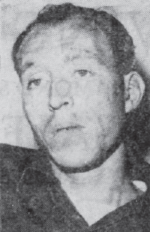 Detroit Free Press, May 29, 1958 On March 4, 1956, a drive-in restaurant in Macomb County, Michigan, was burglarized and a stack of blank checks was stolen. The following day, several of the stolen checks were passed in Mount Clemens, Michigan, by a man who identified himself as Eugene D. Tucker and presented a driver’s license bearing the same name. Police were able to quickly locate and arrest 24-year-old Eugene D. Tucker, who lived in Port Huron, Michigan, since his name and address had been provided when the bad checks were passed. Tucker had a criminal record that included a past burglary conviction. The three shop employees who had accepted the fraudulent checks from the perpetrator viewed Tucker in a lineup. One of these three eyewitnesses positively identified Tucker. This employee also identified Tucker’s girlfriend as having accompanied him into the shop. Based on the identification and the use of a driver’s license bearing his name and address, Tucker was indicted. Roy W. Rogensues, chief assistant prosecutor of Macomb County, prosecuted Tucker’s case. Although Tucker claimed his wallet had been missing since several days prior to the crimes and presented four alibi witnesses to testify that he had been in Port Huron when the crimes occurred, it was not enough to overcome the evidence against him. In May 1956, Tucker was convicted and sentenced to four to fourteen years in prison. Approximately six months after his conviction, Tucker wrote a letter to Rogensues, in which he stated that since his trial, he had realized that he may have been in jail in Port Huron on March 5, 1956. Rogensues looked into this claim and confirmed that Tucker had indeed been booked in the jail in Port Huron at 3:50 p.m. on that date. The shopkeepers described the bad checks as being passed between 2:00 and 4:00 p.m. Mount Clemens is approximately a thirty minute drive from Port Huron, which made it possible – thought unlikely – that Tucker had committed the crimes. The very narrow time frame caused Rogensues to investigate further. Recalling Tucker’s claim that his wallet was missing at the time of the crimes, Rogensues obtained the list of items on Tucker’s person when he was booked at the Port Huron jail on March 5. The list did not include a wallet or driver’s license. With this information, Rogensues requested the complete police file on Tucker’s case. From the file, Rogensues learned that Tucker had submitted to two lie detector tests, which were found to be inconclusive but the examiner had stated that he believed Tucker was being truthful when he stated that he had not passed the bad checks. Rogensues also learned for the first time that a handwriting expert had been called in by police and the expert had been unable to say to say whether Tucker had been the person who had signed the stolen checks. Investigating further, Rogensues looked for other similar crimes that had taken place around the same time frame. He found a nearly identical crime that had occurred nearby while Tucker was in jail, in which the stolen driver’s license of a businessman was used to pass four checks in the exact same dollar amount as those passed in Tucker’s case. Unlike Tucker, however, the businessman had not been prosecuted – his claim that his license was stolen had been believed. Rogensues had police pull together a collection of photographs of all the known forgers in the area and these photos were shown to the four witnesses who had accepted the bad checks in this second crime. All four witnesses picked out the same photo. Based on these identifications, Rogensues came to believe that Evan E. Dake, an acquaintance of Tucker’s younger brother, had committed the crimes for which Tucker had been convicted. Rogensues located Dake, a Port Huron resident, in Missouri State Prison, where he was serving time on a bad check charge. Dake denied the Michigan crimes but did admit that he had worked at the drive-in restaurant from which the checks at issue had been stolen. In addition, Rogensues learned that Tucker’s girlfriend had been in jail at the time of the crimes for which Tucker was convicted. The one employee who had identified Tucker in a lineup had also identified his girlfriend. Since the girlfriend had been in jail at the time of the crimes, the employee’s identification of her had clearly been an error. This led Rogensues to question this witness’s reliability in her identification of Tucker as well. Thoroughly convinced of Tucker’s innocence, Rogensues motioned the court for a new trial in May 1958. This motion was granted and the forgery charges against Tucker were dropped several days later. – Meghan Barrett Cousino
|